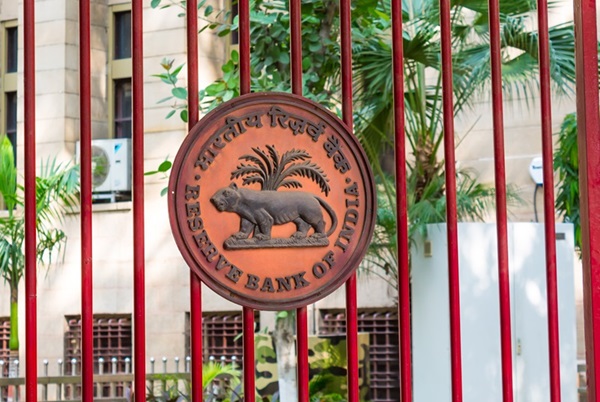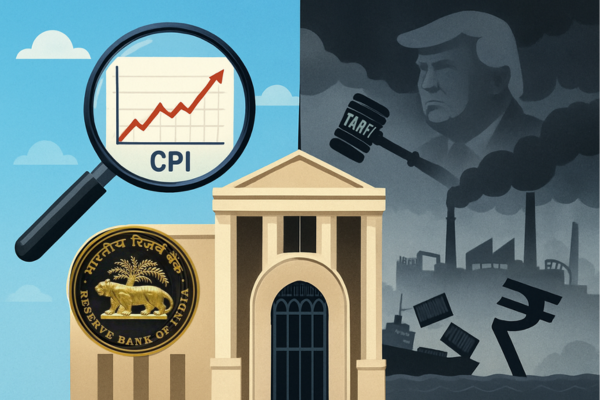.png)
India’s Wage Malaise Leaves RBI Little Room to Hide
With inflation subdued and nominal growth slipping, structural reforms and monetary easing must work together. The October policy is a test of intent.

Yield Scribe is a bond trader with a macro lens and a habit of writing between trades. He follows cycles, rates, and the long arc of monetary intent.
September 23, 2025 at 6:42 AM IST
India’s economy enters October weighed down by contradictions. The headlines celebrate growth of 7.8% in the April to June quarter, the fastest among major economies, yet the foundations look fragile. Nominal GDP growth of only 8.8%, against a budgeted 10.1%, reveals the weakness hidden behind a deflator of barely 0.9%.
Growth is outpacing inflation, but not in a way that signals strength. At best, the year to March 2026 may deliver 6.5% growth if the US maintains its punishing tariffs of 50%. That would keep India ahead of its peers, while still leaving the economy short of its potential growth of 7%.
The risks are not just statistical, as trade frictions, foreign portfolio outflows and the latest blow from Washington in the form of a $100,000 H-1B visa fee that threatens remittances are darkening the global backdrop.
Domestic consumption has gained some support from the government’s GST and personal income tax cuts, but these are low-hanging fruit in the reform orchard. Deeper changes in land and labour markets remain elusive. In the meantime, bond yields have climbed 30-50 basis points across maturities since June, undermining monetary transmission.
The rupee, too, has stayed under pressure even as the dollar index has softened.
Nominal Trap
This divergence between real and nominal growth brings the central dilemma into focus.
Is a low nominal GDP a cause for worry or a high real GDP a cause for celebration? Undoubtedly, for an emerging market economy like India, it is reasonable to focus on nominal because it filters out the deflator volatility and represents the actual state of economic output. Yet the RBI has given preference to one-year-ahead inflation and sacrificed potential growth in the present.
Core inflation is equally revealing. August’s reading, excluding petrol, diesel and gold, slipped to 3.1%, with the full year likely to average about 3.5%. Such consistently low core inflation is puzzling for an economy still described as fast-growing and labour-intensive. It does not reflect surging productivity. Instead, it exposes a deeper wage malaise.
Urban wages have stagnated in real terms. Rural incomes, cushioned by two good monsoons, have fared slightly better, but the weakness in cities is undeniable. The IT industry, long the flagbearer of white-collar employment, has spent recent years on buybacks and dividends rather than capital expenditure to move up the value chain. The global artificial intelligence wave passed India by, leaving the sector reliant on sweatshop coding while US policymakers signalled that the exceptional partnership with India was fraying. Even before the outsourcing taxes and visa restrictions, IT hiring had frozen, and salary growth was anaemic.
This wage problem extends beyond technology. Across corporate India, EBITDA growth has rested on tax breaks and wage optimisation. A 5% annual salary increase now passes for generous. Incremental profits are funnelled into shareholder payouts, with even professional managers incentivised by the metric of wealth creation. In such an environment, household consumption cannot gain traction. Private capital expenditure, often touted but rarely visible, remains hostage to this weak demand. Government spending is the only real investment engine.
Transmission Test
The October policy meeting gives the RBI a chance to act. A 25-basis-point cut would be consistent with the outlook, maintaining a real rate of about 100 to 120 basis points while staying faithful to the inflation mandate.
Waiting until December might allow more clarity on US tariffs, second-quarter GDP and post-GST inflation prints. Cutting during the festive season, however, could deliver a psychological boost to spending precisely when households are inclined to consume. Even without an immediate move, signalling awareness of the disinflation shock and acknowledging growth headwinds would help. Brushing aside GST reductions as mere statistical noise would amount to sacrificing growth unnecessarily.
Bond markets also demand attention, as since June, yields have risen despite the neutral stance, revealing a breakdown in transmission. Supply dynamics explain part of it, but the RBI, as manager of government finances, cannot ignore the cost of borrowing. State development loans are emerging as a structural risk. Their gross issuance could exceed that of the central government in a few years, and their persistent long-dated supply already distorts the curve. Active debt management is overdue.
The RBI can consolidate ISINs, switch auction formats, enable credit ratings for state paper to widen foreign investor access, and arrange buybacks or switches akin to central government bonds. Unless these tools are deployed, any rate cut risks being diluted by higher market yields. Communication matters here as well. Acknowledging the issue and outlining a framework for managing SDL supply would restore credibility.
Beyond bonds, the rupee’s weakness underscores the need for a holistic approach. The fact that the currency has slipped despite a soft dollar index reflects India’s vulnerability to portfolio flows and trade shocks. A lower real interest rate would not necessarily worsen the problem. It could, in fact, support growth sufficiently to reassure investors about medium-term prospects.
Reform, Rate Cut
The government has shown willingness to move on to politically easier reforms, such as GST rationalisation and personal income tax relief. Land and labour reforms remain distant, but even these partial measures signal intent. For the RBI, the corresponding responsibility is to ensure that the monetary stance complements reform rather than undermines it. That means recognising that low inflation is an opportunity, not a threat.
The lesson from the past decade globally is that credibility is built not by opacity but by transparency. The RBI’s new leadership has favoured open communication on liquidity and rate expectations. This is a sound departure from the old central banking habit of mystique. Yet credibility also depends on aligning words with actions. If transmission is broken and growth is stalling while inflation is subdued, inaction risks looking like denial.
India’s economic story is still one of promise, but it is clouded by stagnant wages, hesitant private investment and external shocks. The October policy offers the chance to reset. Whether by cutting rates now, laying the groundwork for December, or addressing bond-market dysfunction, the RBI must show that it sees the risks as clearly as the data suggest.
Structural reforms carry political costs. Monetary easing carries risks of its own. Together, though, they offer a path to revive demand without compromising stability. The real danger lies not in acting, but in waiting too long while wages languish, output gaps widen, and growth potential erodes.



